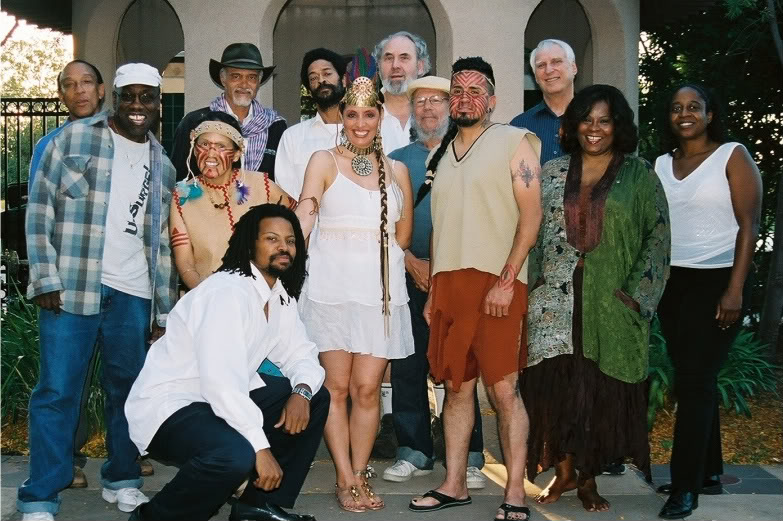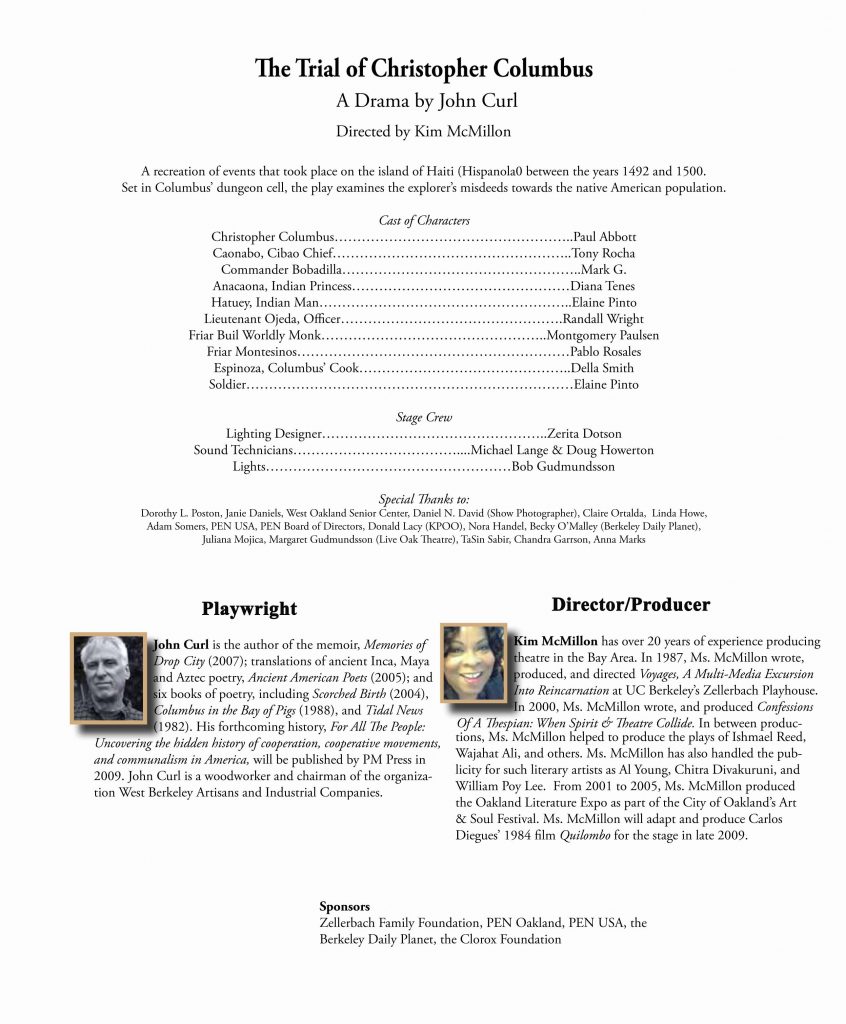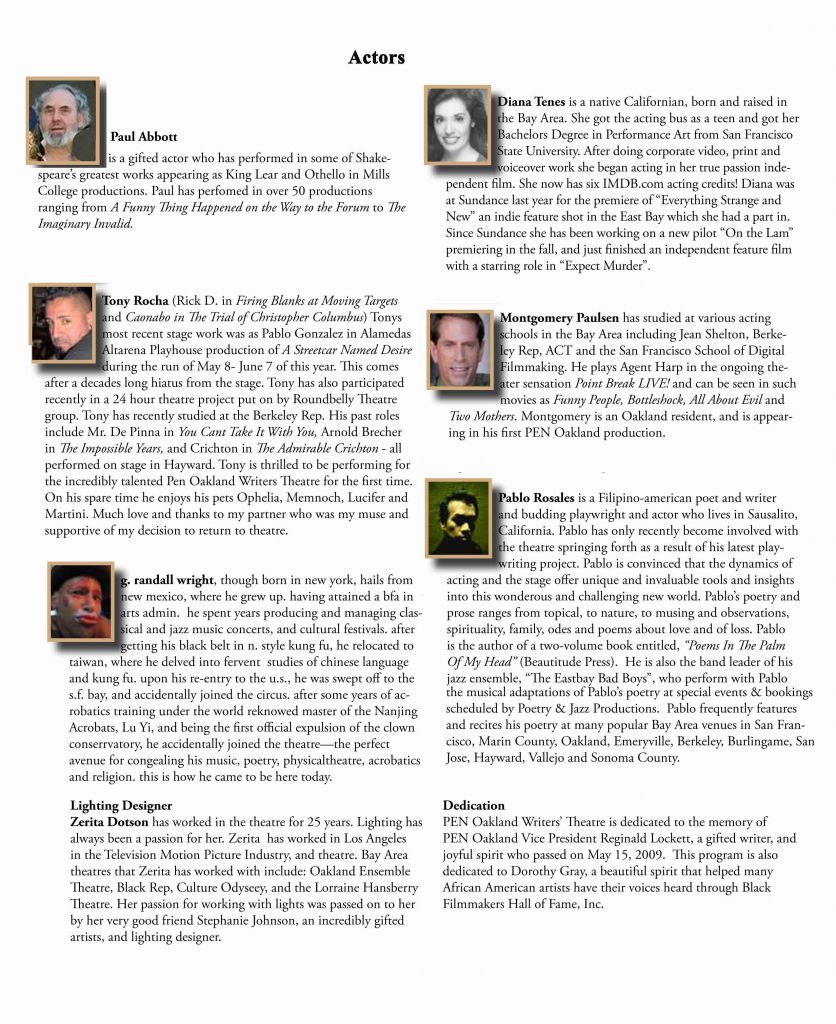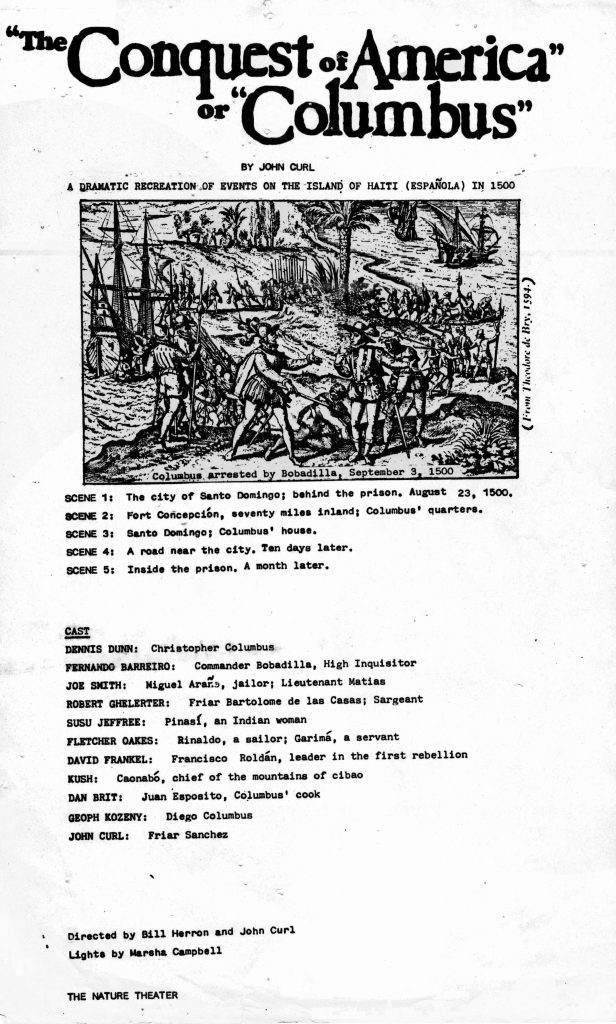A Drama by John Curl

CHARACTERS
CHRISTOPHER COLUMBUS
CAONABO, chief of Haiti
COMMANDER BOBADILLA, Royal Inquisitor
ANACAONA, an Indian woman, spiritual leader
HATUEY, a young Indian man
LIEUTENANT OJEDA, a career officer
FRIAR BUIL, a worldly monk
FRIAR MONTESINOS a young idealist
ESPINOZA, Columbus’ cook and valet
SOLDIER
Produced as a staged reading by
The PEN Oakland Writers’ Theater
at Live Oak Theatre, Berkeley, CA
September 17 & 18, 2009
Directed by Kim McMillon
CAST
Christopher Columbus………………Paul Abbott
Caonabo …………………………….Tony Rocha
Commander Bobadilla……………..Mark G.
Anacaona……………………….…..Diana Tenes
Hatuey…………………………….…Elaine Pinto
Lieutenant Ojeda……………………Randall Wright
Friar Buil………………………….…Montgomery Paulsen
Friar Montesinos……………………Pablo Rosales
Espinoza……………………………..Della Smith
Soldier……………………………..…Elaine Pinto

PREFACE
The Trial of Columbus is an historical drama, a creative recreation of events that took place in the year 1500 on the Caribbean island of Hispaniola, today shared by the Dominican Republic and Haiti.
The myths surrounding Columbus form a core part of the traditional American origin legend, embedded in the deepest layers of our childhood consciousness, attempting to answer the basic questions of where we came from, how we got here, and by extension who we are. The Trial of Columbus attempts to look unflinchingly into the heart of the Columbus mythology and perhaps reveal some historical truths.
The play takes place in a dungeon cell, where Columbus has been cast after being deposed from his command as Governor of the island. Columbus is stunned to find he shares his cell with Caonabó, chief of the Tainos. The two deposed leaders, Columbus and Caonabó, both in chains, struggle with each other as they await their destinies.
In 2009 I was fortunate to be able to stage a production of The Trial of Columbus through the PEN Oakland Writers’ Theater, beautifully directed by Kim McMillon, with a cast of very talented actors led by Paul Abbott, Diana Tenes, and Tony Rocha, and performed at the Live Oak Theater in Berkeley.
Through reading Columbus’s letters and the actual log of his first voyage, which really still exists, I got an inside view of his mind and personality, his overblown arrogance and Faustian bluster. I wanted to recreate this saga, to bring the history to life in order to dispel the mythology, and I found Columbus’s nemesis not in Commander Bobadilla, who deposed him, but in Caonabó, the great Taino chieftain.
Most of the voluminous Columbus literature up until recently presented the history as the heroic saga of a great explorer, while his role in leading the invasion of the Americas, his genocide of the Native people, and his founding of the transatlantic slave trade were all omitted or relegated to footnotes. I came to understand that mainstream culture had replaced the history with prettified lies, while the truth continued to eat at the heart of our society like a cancer.
My first contact with the truth about Columbus took place around 1980, when I was doing some construction work for a homeowner in Oakland. She offered me a box of old magazines. On top of the stack was a beautiful Kuna Indian woman with a gold ring in her nose, the cover of the November, 1975 issue of National Geographic. I opened it to a photo of a hawk with a small bell tied to its foot, in an article about Columbus’s voyages in the Caribbean. The photo caption read, in part, “His greed awakened, Columbus demanded of each adult an annual tribute: enough gold dust to fill four hawkbells. Pay or perish. Many Indians fled, but the Spaniards tracked them down with dogs. Thousands ended their lives with poison. In 1492 an estimated 300,000 Indians lived on Hispaniola. By 1496 a third of them were dead. Less than a decade later the first black slaves arrived to take over the Indians’ oppressive burdens.”
I wrote an early draft of this play in 1981, and staged a reading of it in San Francisco, directed by Bill Herron, with all the parts played by poets and other friends. Kush, who ran Cloud House poetry center, hosted it in a series of plays (the Nature Theater of Oklahoma) in 1981-’82, and he played Caonabó.
I have written other works on the theme of Native resistance to Columbus and his invasion, including my long poem Columbus in the Bay of Pigs (1988, 1991), my video The Columbus Invasion (1991), and my documentary history Indigenous Peoples Day (2017).
You can download The Trial of Christopher Columbus play HERE.



0 Comments